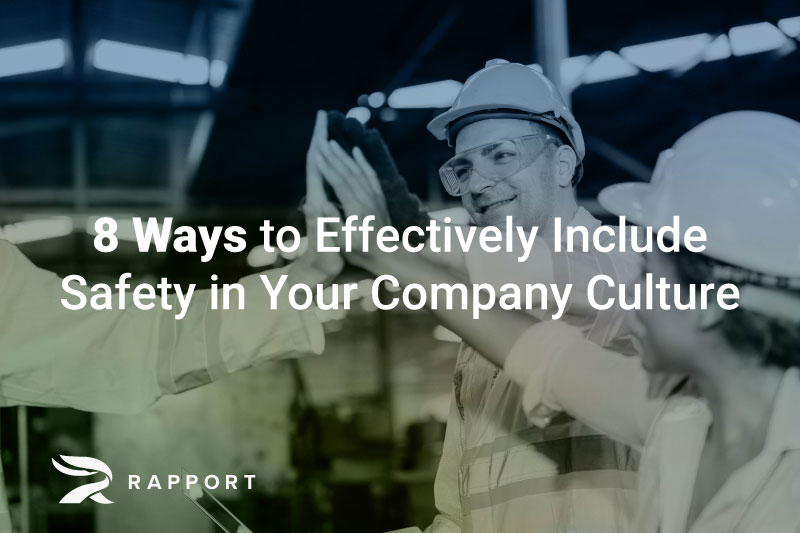8 Ways to Effectively Include Safety in Your Company Culture

Employees are every organization’s best asset. Because of this, keeping them happy, healthy, and safe is paramount to the success of the business.
While you likely understand the importance of building a safety culture in the workplace, you may find it difficult to implement in your organization. This could be due to a few different reasons. For example, you may be a relatively new company and you aren’t sure how to create this culture of safety from scratch or the organization has been around for years (if not decades) and employees and leadership are stuck in a “this is the way we’ve always done it” mindset.
Either way, there is no better time than the present to revamp how your organization regards workplace safety. Keep reading to learn how.
Why Your Company Culture Needs Safety Culture
Whether your employees spend their day in an office, a manufacturing plant, a healthcare setting, a school, a retail store, or any other workplace environment, potential dangers are everywhere. According to the Bureau of Labor Statistics, 2.7 million nonfatal workplace injuries and illnesses were reported in 2020. That’s approximately 2.7 cases per 100 full-time workers. Consider how many of these injuries could have been prevented if leadership put more of a focus on safety in the workplace.
Workplace injuries are not only detrimental to individual employees, they also cost companies billions of dollars every year. This money reflects worker’s compensation costs, lost productivity while an employee is on leave, and high turnover rates that lead to increased hiring and onboarding costs.
Fortunately, it doesn’t have to be like this.
When companies commit to establishing and nurturing a culture of safety in their organization, they see fewer incidents and injuries, keep turnover low, and foster trust and loyalty among their employees.
For many, this culture requires a mindset shift as every worker and manager within the organization must recognize safety as a priority. Safety is the responsibility of every individual and must become an essential part of the day-to-day.
8 ways to Include Safety in Your Company Culture
Now that you understand the importance of a safety culture, it’s time to create (or tweak) your company’s safety mindset and protocols. These eight tips will ensure that you can easily incorporate this culture into your organization.
1) Assess Your Current Safety Culture
Before you begin making changes, it’s important to determine how your organization ranks when it comes to safety. Here are a few questions to pose not only to management but also to your frontline workers.
- Is every individual in the company aware of current safety standards and expectations?
- How committed are employees, managers, and independent contractors to promoting safety?
- Are there repeat mistakes that occur and have not been dealt with on a large scale (ie: policy change)?
- Are safety protocols well-documented and easily accessible by every employee? Simply having them in place is not sufficient. They must also be communicated to the entire staff.
- What needs to be added to your safety culture?
- What type of safety training do employees receive when they are onboarded? Is it continuous to help them stay up-to-date?
Once you understand where your organization is, you’ll be better able to identify gaps and opportunities for improvement.
2) Enlist Top Management to Lead by Example
Much like general workplace culture, safety culture begins at the top and trickles down. In order to truly establish safe practices in your organization, managers must be fully on board with the plans and make safety a core value for the company. In addition, they must follow protocol and show their employees that they, too, prioritize safety and understand that it’s everyone’s responsibility.
This requires management training so that, even if managers don’t perform the daily tasks that can lead to workplace injuries, they are still familiar with the protocols put in place to keep everyone safe. You will also look to your leadership to establish safety goals, set the program expectations and responsibilities, and provide ongoing resources and support for the program.
3) Provide Continuous Safety Training
While onboarding and new employee training are important to workplace safety, this type of training needs to be ongoing throughout a worker’s employment with your organization. Safety courses will serve as a refresher on proper protocols and will also remind employees of the importance of being safe and responsible on the job.
Rapport’s Breakthrough Safety Training focuses on the essential competencies employees need and provides the necessary skills to keep your team safe.
4) Encourage Open Communication About Safety Concerns
Communication is important in every aspect of business and safety is no different. Employees must feel comfortable approaching management about their safety concerns and potential threats to employees or the organization as a whole.
Employees must never be afraid to bring a safety concern to light and must have the freedom to share their ideas about potential fixes, as well.
5) Place Safety Messaging All Around The Workspace
While safety goals and expectations must be written into training manuals, corporate documents, and “big picture” communications, it’s important that they also become a part of employees’ daily lives. Utilize posters, signage, email campaigns, and any other available communications to remind employees of the importance of safety and to reinforce key messages. This will help build engagement among employees making it a safer environment for all.
6) Check Employee And Equipment Certifications
When was the last time you reviewed your employees’ certifications? Heavy machinery, equipment, and any other technology that could pose a safety hazard, often requires operators to be licensed or certified to do their job.
Routinely review requirements with individual employees and make it easy and convenient for them to receive the training and certification they need. This will ensure that you are doing everything on your part to keep all employees protected.
7) Reward Safety
Chances are that your organization already recognizes and rewards individuals who make their sales or production numbers, provide excellent customer service, and support their team. That’s a great start to communicating what’s truly important to your organization. The next step is rewarding safety.
Recognize employees that are always looking out for their own wellbeing, as well as the safety of others. Utilize signs to communicate how safety initiatives are going, including how long it’s been since the last injury. Thank your employees for contributing to this culture of safety and provide positive reinforcement whenever possible.
8) Keep Assessing Safety Progress
Rome wasn’t built in a day and your safety protocols won’t be either. Approach this safety culture as a constantly improving system. Review where you are at, implement programs, and then identify:
- What’s working
- What’s not
- What needs to be done to improve
Then, implement changes and repeat the process. With every iteration, your workplace will become safer.
Establish Workplace Safety With Our Breakthrough Safety Course
Without a strong focus on the safety and wellbeing of your staff, your employees are in danger and your organization is in jeopardy. Thankfully, implementing safety in your company culture doesn’t have to be a frightening endeavor.
Rapport’s Breakthrough Safety Training provides learners with the skills and tools they need to create a safe and positive workplace. This 2.5-day experiential training course will cover policy, compliance, structure, and communication to ensure that your employees are prepared. Enroll your team today and create a strong commitment to safety for your organization!


